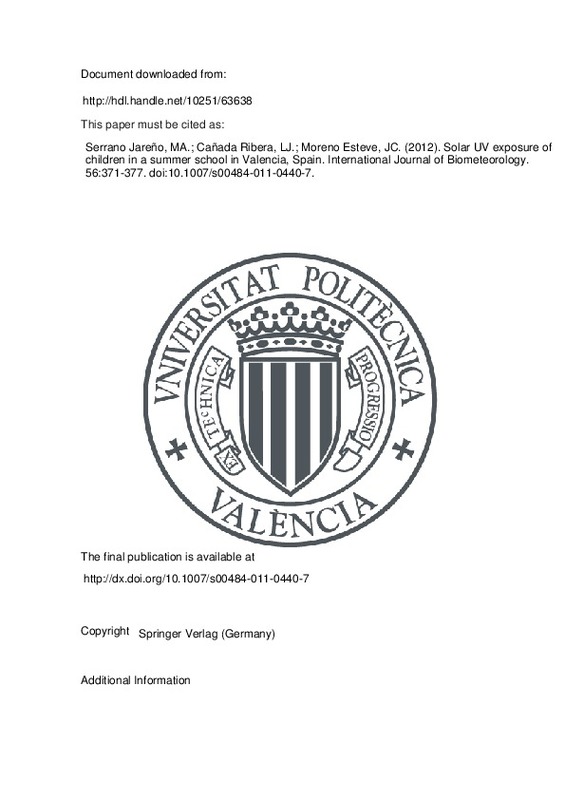Agencia Estatal de Meteorología. http://www.aemet.es/ . Accessed 5 March 2010
Armstrong BK (2005) How sun exposure causes skin cancer: an epidemiological perspective, In: Hill D, Elwood JM, English DR (eds) Prevention of skin cancer. Kluwer, Dordrecht, pp 89–116
Armstrong BK, Kricker A (2001) The epidemiology of UV induced skin cancer. J Photochem Photobiol B 63:8–18
[+]
Agencia Estatal de Meteorología. http://www.aemet.es/ . Accessed 5 March 2010
Armstrong BK (2005) How sun exposure causes skin cancer: an epidemiological perspective, In: Hill D, Elwood JM, English DR (eds) Prevention of skin cancer. Kluwer, Dordrecht, pp 89–116
Armstrong BK, Kricker A (2001) The epidemiology of UV induced skin cancer. J Photochem Photobiol B 63:8–18
Biosense Laboratories. http://www.biosense.de/viosp-e.htm . Accessed 5 March 2010
Boldeman C, Dal H, Wester U (2004) Swedish pre-school children’s UVR exposure - a comparison between two outdoor environments. Photodermatol Photoimmunol Photomed 20:2–8
Fitzpatrick TB, Pathak M, Parrish JA (1974) Protection of human skin against the effects of the sunburn ultraviolet (290–320 nm). In: Pathak MA, Harber LC, Seiji M, Kukita A (eds) Sunlight and man: normal and abnormal photobiologic responses. University of Tokyo Press, Tokyo
Furusawa Y, Quintern LE, Holtschmidt H, Koepke P, Saito M (1998) Determination of erythema-effective solar radiation in Japan and Germany with a spore monolayer film optimized for the detection of UVA and UVA - results of a field campaign. Appl Microbiol Biotechnol 50:597–603
Grant WB, Holick MF (2005) Benefits and requirements of vitamin D for optimal health: a review. Altern Med Rev 10:94–104
Guy CY, Diab RD, Martincigh BM (2003) Ultraviolet radiation exposure of children and adolescents in Durban, South Africa. Photochem Photobiol 77:265–270
IARC (2000) IARC monographs on the evaluation of carcinogenic risks to humans: solar and ultraviolet radiation 55. IARC, Lyon
International Commission on Illumination (1997) Standard erythema dose, a review. CIE J 125:1–5
International Commission on Non-Ionizing Radiation Protection (1995) Global Solar UV Index. ICNIRP-1/95
International Commission on Non-Ionizing Radiation Protection (ICNIRP) (2004) Guidelines on limits of exposure to ultraviolet radiation of wavelengths between 180 nm and 400 nm (incoherent optical radiation). Health Phys 87:171–186
International Non-Ionizing Radiation Committee of the International Radiation Protection Association (1985) Guidelines on limits of exposure to ultraviolet radiation of wavelengths between 180 nm and 400 nm (incoherent optical radiation). Health Phys 49:331–340
Kimlin M, Parisi A (2001) Usage of real-time ultraviolet radiation data to modify the daily erythemal exposure of primary schoolchildren. Photodermatol Photoimmunol Photomed 17:130–135
McKinlay AF, Diffey BL (1987) A reference action spectrum for ultraviolet induced erythema in human skin. CIE J 6:17–22
Moehrle M, Dennenmoser B, Garbe C (2003a) Continuous long-term monitoring of UV radiation in professional mountain guides reveals extremely high exposure. Int J Cancer 103:775–778
Moehrle M, Garbe C (2000) Personal UV dosymetry by Bacillus subtilis spore films. Dermatology 200:1–5
Moehrle M, Korn M, Garbe C (2003b) Bacillus subtilis spore film dosimeters in personal dosimetry for occupational solar ultraviolet exposure. Int Arch Occup Environ Health 173:575–580
Munakata N, Ono M, Watanabe S (1998) Monitoring of solar-UV exposure among schoolchildren in five Japanese cities using spore dosimeter and UV-coloring labels. Jpn J Cancer Res 89:235–245
Norval M, Cullen AP, de Gruijl FR, Longstreth J, Takizawa Y, Lucas RM, Noonan FP, van der Leun JC (2007) The effects on human health from stratospheric ozone depletion and its interactions with climate change. Photochem Photobiol Sci 6:232–251
Oliveria SA, Saraiya M, Geller AC, Heneghan MK, Jorgensen C (2006) Sun exposure and risk of melanoma. Arch Dis Child 91:131–138
Ono M, Munakata N, Watanabe S (2005) UV exposure of elementary school children in five Japanese cities. Photochem Photobiol 81:437–445
Programa meteorología de la Fundación Centro de Estudios Ambientales del Mediterráneo (Generalitat Valenciana). http://www.gva.es/ceamet/vigilancia/radUV/radUV.html . Accessed 15 March 2010
Saraiya M, Glanz K, Briss PA, Nichols P, White C, Das D, Smith SJ, Tannor B, Hutchinson AB, Wilson KM, Ghandi N, Lee NC, Rimer B, Coates RC, Kerner JF, Hiatt RA, Buffler P, Rochester P (2004) Interventions to prevent skin cancer by reducing exposure to ultraviolet radiation: a systematic review. Am J Prev Med 27:422–466
Serrano MA, Cañada J, Moreno JC (2009) Erythemal Ultraviolet exposure in two groups of outdoor workers in Valencia, Spain. Photochem Photobiol 85:1468–1473
Serrano MA, Cañada J, Moreno JC (2010) Erythemal ultraviolet exposure of cyclists in Valencia, Spain. Photochem Photobiol 86:716–721
Serrano MA, Cañada J, Moreno JC (2011) Solar UV exposure of primary schoolchildren in Valencia, Spain. Photochem Photobiol Sci. doi: 10.1039/C0PP00153H
Thieden E, Ågren MS, Wulf HC (2000) The wrist is a reliable body site for personal dosimetry of ultraviolet radiation. Photodermatol Photoimmunol Photomed 16:57–61
Thieden E, Philipsen PA, Heydenreich J, Wulf HC (2004) UV radiation exposure related to age, sex, occupation, and sun behaviour based on time-stamped personal dosimeter readings. Arch Dermatol 140:197–203
World Health Organization (2002) Global Solar UV Index: a practical guide. WHO, Geneva, Switzerland
Wright C, Reeder A (2005) Youth solar ultraviolet radiation exposure, concurrent activities and sun-protective practices: areview. Photochem Photobiol 81:1331–1342
Wright CY, Reeder AI, Bodeker GE, Gray A, Cox B (2007) Solar UVR exposure, concurrent activities and sun-protective practices among primary schoolchildren. Photochem Photobiol 83:749–758
[-]







![[Cerrado]](/themes/UPV/images/candado.png)


